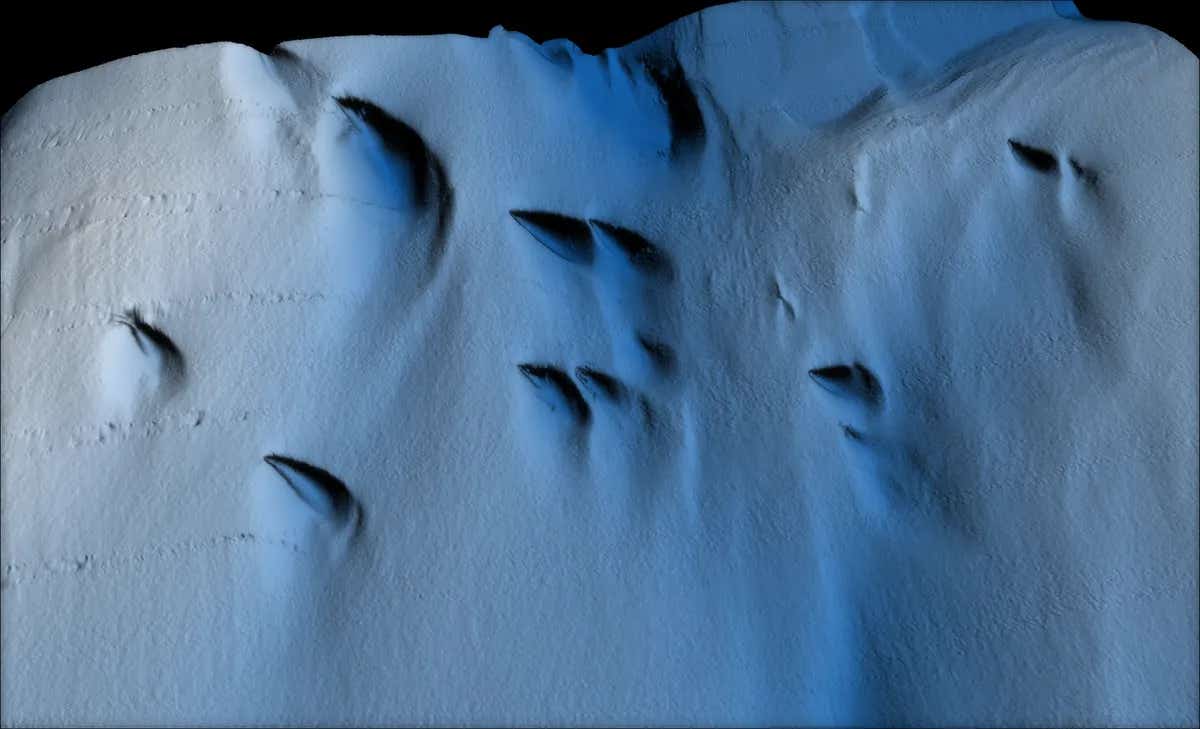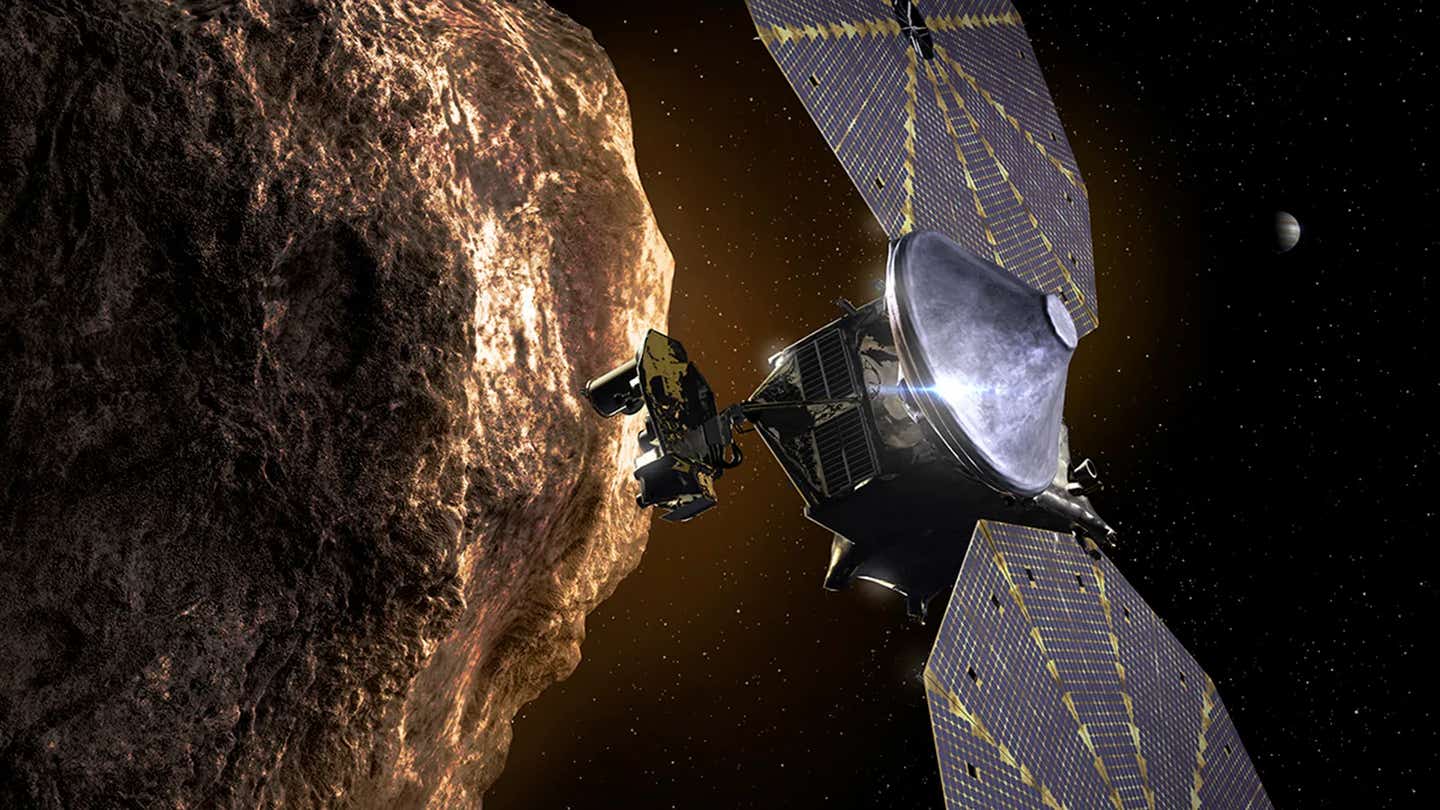Mysterious structure found hidden underneath the Antarctic ice
Researchers deployed a remotely operated vehicle (ROV) named Ran beneath the Dotson ice shelf in West Antarctica.

A visualization of the features seen by the drone. (CREDIT: Filip Stedt / University of Gothenburg)
The world is facing a climate crisis, and monitoring potential tipping points is crucial. These tipping points are critical thresholds that, once crossed, can lead to escalating and potentially irreversible changes in the environment.
In an effort to better understand how the ocean is affecting the melting of Antarctica's ice shelves, researchers deployed a remotely operated vehicle (ROV) named Ran beneath the Dotson ice shelf in West Antarctica. The mission aimed to map the area using sonar technology, providing valuable data on the ice shelf's underside.
Anna Wåhlin, a professor of oceanography at the University of Gothenburg, explained, “We have previously used satellite data and ice cores to observe how glaciers change over time. By navigating the submersible into the cavity, we were able to get high-resolution maps of the ice underside. It's a bit like seeing the back of the moon." This innovative approach allowed the team to gather data that was previously inaccessible.
During the 2022 expedition, Ran traveled over 1,000 kilometers (621 miles) back and forth under the glacier, reaching 17 kilometers (10.5 miles) into a cavity within the ice. This extensive journey provided a detailed view of the glacier's interior, offering new insights into how these massive ice formations interact with the ocean.
Wåhlin emphasized the importance of this research, stating, “Better models are needed to predict how fast the ice shelves will melt in the future. It is exciting when oceanographers and glaciologists work together, combining remote sensing with oceanographic field data. This collaboration is essential to understanding the glaciological changes taking place – the driving force is in the ocean."
The findings from this expedition have revealed some intriguing discoveries. Among them were unusual patterns of peaks and valleys at the glacier's base, where underwater currents are slowly eroding the ice and moving further into the cracks.
Related Stories
Even more surprising were features resembling sand dunes, stretching up to 400 meters (1,300 feet) long, emerging from these rougher-than-expected areas. The team hypothesizes that these formations are a result of water movement beneath the glacier influenced by Earth's rotation.
Wåhlin elaborated on this phenomenon, saying, "If you look closely at the shapes, they are not symmetrical; they are bent a bit like blue mussels, and the reason for that asymmetry is Earth's rotation. Water moving on Earth is subject to something called the Coriolis force, which acts to the left of the direction of motion in the Southern Hemisphere. If we are correct, there is a force balance in the layer closest to the ice where friction is balanced by the Coriolis force."
This pattern of water movement, known as an Ekman Spiral, plays a significant role in the formation of these features. According to the National Oceanic and Atmospheric Administration (NOAA), "When surface water molecules move by the force of the wind, they, in turn, drag deeper layers of water molecules below them. Each layer of water molecules is moved by friction from the shallower layer, and each deeper layer moves more slowly than the layer above it, until the movement ceases at a depth of about 100 meters (330 feet)."
The Coriolis effect, which influences the direction of water movement based on the hemisphere, causes the deeper water to spread asymmetrically. In the Southern Hemisphere, this movement is directed to the left, while in the Northern Hemisphere, it moves to the right. This creates a spiral effect, where deeper layers of water twist around and flow in the opposite direction to the surface current.
The team observed that older "teardrop" shapes had tails more parallel to the flow, as predicted by Ekman theory. However, they acknowledge that more observations are needed to fully understand these complex interactions.
Tragically, since this groundbreaking expedition, the ROV Ran has gone missing beneath the Doomsday Glacier. During its dives, the submersible operated autonomously, following a pre-programmed route and relying on an advanced navigation system to return to open water. Unfortunately, during a mission in January 2024, Ran failed to reach its rendezvous point. Despite extensive searches using acoustic equipment, drones, and helicopters, the team has been unable to locate the submersible.
Wåhlin reflected on the loss, stating, “It’s a bit like looking for a needle in a haystack, but without even knowing where the haystack is. At this point, Ran’s batteries are dead. All we know is that something unexpected happened under the ice. We suspect it ran into trouble, and then something prevented it from getting out."
The team believes that this marks the end of Ran's mission, but they take solace in knowing that it served its purpose in advancing our understanding of the Antarctic ice shelves. As Wåhlin noted, this is a better fate for the submersible than being left to gather dust in a garage. The researchers now plan to replace Ran and continue their vital work, contributing to our knowledge of the Earth's changing climate.
In the face of a rapidly changing world, such research is critical. Understanding the complex interactions between the ocean and the ice shelves is essential for predicting future changes and preparing for the impacts of climate change. The loss of Ran is a setback, but it also underscores the importance of continuing to explore and understand our planet's most remote and fragile environments.
Note: Materials provided above by The Brighter Side of News. Content may be edited for style and length.
Like these kind of feel good stories? Get The Brighter Side of News' newsletter.
Joshua Shavit
Science & Technology Writer | AI and Robotics Reporter
Joshua Shavit is a Los Angeles-based science and technology writer with a passion for exploring the breakthroughs shaping the future. As a contributor to The Brighter Side of News, he focuses on positive and transformative advancements in AI, technology, physics, engineering, robotics and space science. Joshua is currently working towards a Bachelor of Science in Business Administration at the University of California, Berkeley. He combines his academic background with a talent for storytelling, making complex scientific discoveries engaging and accessible. His work highlights the innovators behind the ideas, bringing readers closer to the people driving progress.



